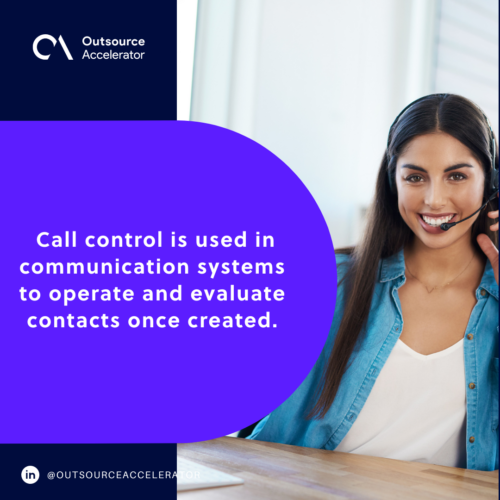Call Control
Definition
What is call control?
In the BPO sector, call control is used in communication systems to operate and evaluate contacts once created. Call control uses software that provides the central function of a telephone switch.
The call control system decodes addressing information and routes calls from one endpoint to the other. It also adds capabilities that customize normal switch functioning to meet the demands of users. These are known as supplemental services, and a Vertical service code usually triggers them.
Call control is also one of three critical types of communications traffic in a VoIP network, with call signaling and media communications being the other two. Call control functions include:
- Determining master status for endpoints.
- Tracking endpoint status.
- Modifying connection settings.
- Terminating a connection.
- Recovering a terminated or unsuccessful connection

How call control works
With call control, when a caller contacts your number for the first time, they must correctly enter a number on their keypad for it to be activated. The call is directed to you, and they will not be called again.
Suppose they do not input the correct number. In that case, the caller will receive an automatic message stating that they have not reached you. This filtering technique keeps automated calls out while allowing real-life callers to pass.
You can add phone numbers to your approved list to prevent them from being vetted when they try to contact you.
Strategies for call control
A call center’s capacity to regulate calls is one of its most significant capabilities. An agent’s call control skills will be helpful in several situations, including when a customer is angry or wants to keep chatting without getting to the point.
Pay attention, guide the caller, be calm, professional, and kind. Keeping focused on assisting them in finding a solution is the best way for reasonable call control.
Provide individualization
After answering the phone with a friendly tone, it’s crucial to make the customer feel valued, not like they’re just another number on the line.
The call handler should also ask for the caller’s name in addition to their own. This section of the greeting and the rest of the conversation should be genuine and flow naturally – they shouldn’t sound like they’re checking boxes of questions they need to ask.
Segment the conversation
When we segment an exchange, we mean we divide it into manageable chunks. Large chunks are utilized for broad ideas or the big picture; little pieces are helpful for specific information or minute details.
Make use of more closed questions
These questions will provide you with a yes or no answer or specific information that you have requested.
Short or one-word responses will allow you to enter the information into the computer or write it down as soon as you hear it. If required, seek quick reactions so that you can put them into your system as they speak.
Resolve objections
You can try to avoid complaints by showcasing your company’s value and detailing your appointment process. Collaborate with your team to develop phrases and talk tracks for some of the most typical call handlers’ arguments while interacting with consumers.







 Independent
Independent




